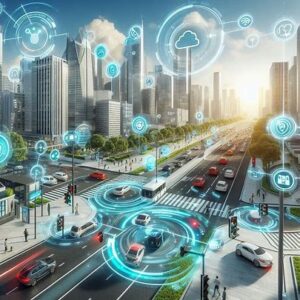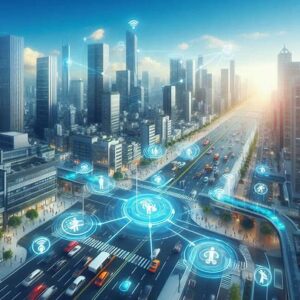
Introduction
Picture a city where traffic jams are rare, accidents are minimized, and commuting is faster and greener. This vision is becoming reality with smart traffic systems, a technology that uses sensors, data analytics, and connectivity to optimize traffic flow and enhance road safety. By integrating devices like cameras, IoT sensors, and artificial intelligence, smart traffic systems are transforming urban mobility, reducing congestion, and improving quality of life. This article explores what smart traffic systems are, how they work, their real-world applications, current trends, and their potential to shape the future of transportation, all in an engaging and accessible way.
What are Smart Traffic Systems?
Smart traffic systems are advanced networks of technologies designed to manage and optimize traffic in real-time. These systems collect data from roads, vehicles, and infrastructure, analyze it using AI and other tools, and make decisions to improve traffic flow, safety, and efficiency. Unlike traditional traffic management, which relies on fixed schedules or manual intervention, smart traffic systems adapt dynamically to changing conditions.
Key Components
- Sensors and Cameras: Capture data on traffic volume, speed, and road conditions.
- IoT Devices: Connect traffic lights, signs, and vehicles to a central system.
- AI and Data Analytics: Process data to predict congestion and optimize signal timings.
- Communication Networks: Enable real-time data exchange, often using 5G or dedicated short-range communications (DSRC).
- User Interfaces: Apps or dashboards provide drivers with real-time traffic updates.
For example, a smart traffic light might detect heavy traffic in one direction and adjust its timing to prioritize flow, reducing wait times.
How Smart Traffic Systems Work
Smart traffic systems operate through a cycle of data collection, analysis, and action. Here’s a simplified process:
- Data Collection: Sensors, cameras, and GPS devices gather real-time data on traffic density, vehicle speeds, and incidents like accidents.
- Data Transmission: Information is sent to a central system or processed locally via edge computing, often using 5G for speed.
- Analysis and Decision-Making: AI algorithms analyze data to predict congestion, optimize signal timings, or reroute traffic.
- Action: The system adjusts traffic lights, updates navigation apps, or sends alerts to drivers and city officials.
- Feedback Loop: Continuous monitoring refines the system’s performance, adapting to new patterns.
For instance, if a sensor detects a traffic jam, the system might extend green light durations or suggest alternate routes to drivers via apps like Waze.
Real-World Applications of Smart Traffic Systems
Smart traffic systems are reshaping urban environments, offering solutions to longstanding transportation challenges.
Traffic Flow Optimization
In cities like Singapore, smart traffic systems use AI to adjust signal timings based on real-time traffic data, reducing congestion by up to 15%. Cameras and sensors monitor vehicle flow, ensuring smoother commutes during peak hours.
Road Safety
Smart systems enhance safety by detecting hazards and alerting drivers. For example, in Stockholm, smart intersections warn drivers of pedestrians or cyclists using connected signs, reducing accidents. Vehicle-to-infrastructure (V2I) communication allows cars to receive alerts about road conditions.
Public Transportation
Smart traffic systems prioritize buses and trams to improve public transport efficiency. In London, smart signals give buses green lights during peak times, cutting travel times and encouraging ridership.
Emergency Response
These systems expedite emergency services by creating “green corridors.” In Los Angeles, smart traffic lights prioritize ambulances and fire trucks, clearing paths to save critical minutes.
Environmental Benefits
By reducing idling and optimizing routes, smart traffic systems lower emissions. Copenhagen’s smart traffic network has cut CO2 emissions by optimizing traffic flow and promoting cycling through connected infrastructure.
News shapes markets. Be the first to act, not react. Learn how in our finance hub.

Current Trends in Smart Traffic Systems
As of June 2025, smart traffic systems are evolving rapidly, driven by technological advancements and urban growth. Here are key trends:
Integration with 5G
5G’s low latency and high bandwidth enable real-time communication between vehicles, infrastructure, and control centers. This supports applications like vehicle-to-everything (V2X) communication, where cars exchange data with traffic systems for smoother navigation.
AI and Machine Learning
AI is enhancing predictive capabilities. Machine learning models, like those used in Toronto’s traffic systems, analyze historical and real-time data to forecast congestion, enabling proactive adjustments.
Vehicle-to-Infrastructure (V2I) Communication
V2I systems allow vehicles to interact with traffic infrastructure. In the U.S., pilot projects in Michigan use V2I to warn drivers of upcoming red lights, reducing hard braking and fuel use.
Smart City Ecosystems
Smart traffic systems are integral to smart cities. In Dubai, integrated systems connect traffic management with energy and waste systems, creating holistic urban solutions.
Autonomous Vehicle Support
Smart traffic systems are crucial for self-driving cars. In San Francisco, Waymo’s autonomous vehicles communicate with smart intersections to navigate complex urban environments safely.
Benefits of Smart Traffic Systems
Smart traffic systems offer significant advantages:
- Reduced Congestion: Optimized signal timings and routing cut travel times.
- Improved Safety: Real-time hazard detection reduces accidents.
- Environmental Impact: Lower idling and emissions support sustainability goals.
- Cost Savings: Efficient traffic reduces fuel costs and infrastructure wear.
- Enhanced Mobility: Prioritizing public transport and emergency services improves urban accessibility.
Challenges of Smart Traffic Systems
Despite their potential, these systems face hurdles:
- High Costs: Deploying sensors, cameras, and connectivity infrastructure is expensive, especially for smaller cities.
- Data Privacy: Collecting traffic and vehicle data raises concerns about surveillance and data security.
- Interoperability: Integrating systems across regions or vendors can be complex due to differing standards.
- Maintenance: Continuous upkeep of sensors and software is resource-intensive.
- Digital Divide: Rural areas may lag in adoption due to limited funding and connectivity.
Addressing these requires investment, standardized protocols, and robust cybersecurity measures.
The Future of Smart Traffic Systems
By 2030, smart traffic systems are expected to transform urban mobility further:
- Fully Autonomous Traffic: Systems will manage entire cities’ traffic flows, coordinating with autonomous vehicles for seamless movement.
- Global Standards: Unified protocols will enable cross-border traffic management, benefiting international trade and travel.
- Sustainability Focus: Integration with renewable energy and electric vehicle charging networks will reduce urban carbon footprints.
- Personalized Mobility: AI-driven apps will provide tailored route suggestions, balancing individual and city-wide needs.
Public-private partnerships and global cooperation will be key to scaling these systems equitably.

Conclusion
Smart traffic systems are revolutionizing how we navigate cities, using technology to reduce congestion, enhance safety, and promote sustainability. From optimizing traffic flow in Singapore to supporting autonomous vehicles in San Francisco, their applications are diverse and impactful. As trends like 5G integration, AI advancements, and smart city ecosystems drive progress, these systems promise a future where urban mobility is efficient, safe, and environmentally friendly. By addressing challenges like cost and privacy, smart traffic systems can pave the way for smarter, more connected cities, improving the quality of life for millions.



